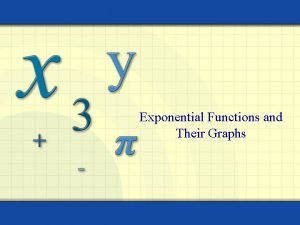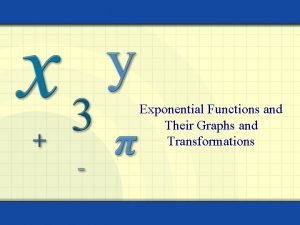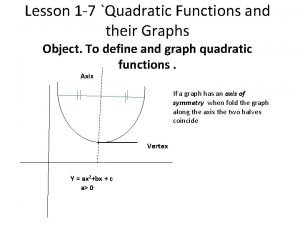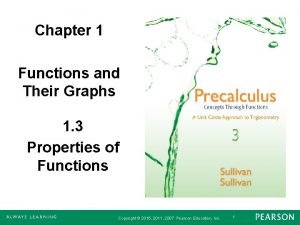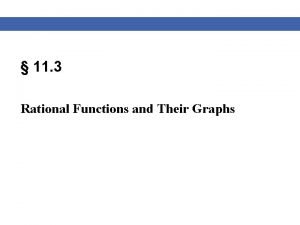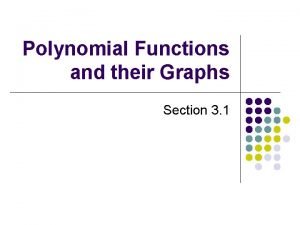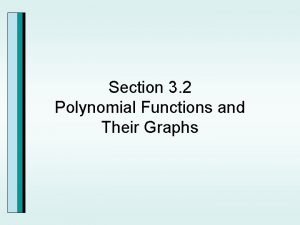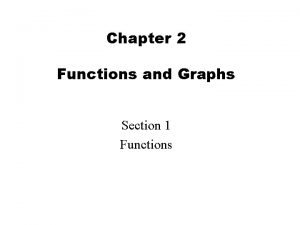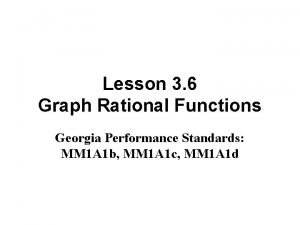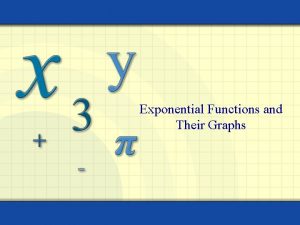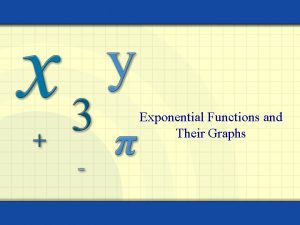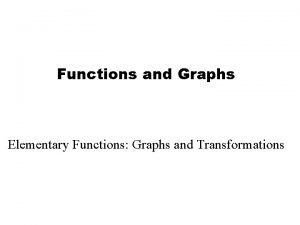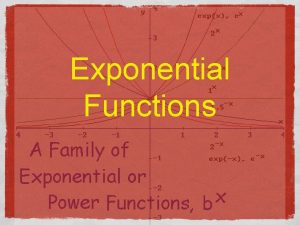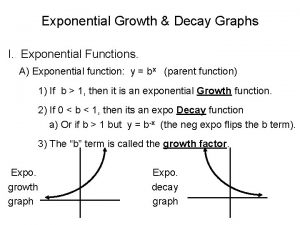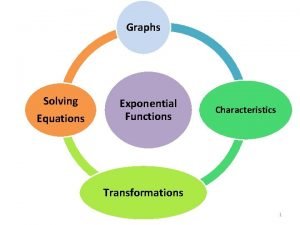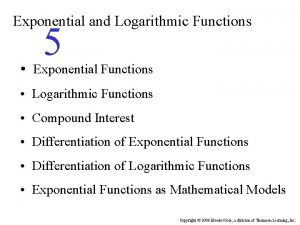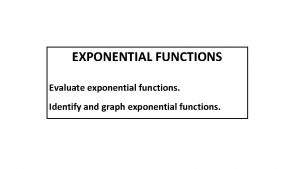Exponential Functions and Their Graphs and Transformations Warm




















- Slides: 20

Exponential Functions and Their Graphs and Transformations

Warm Up 4 In 2000, the world population was 6. 08 billion and was increasing at a rate 1. 21% each year. 1. Write a function for world population. Does the function represent growth or decay? P(t) = 6. 08(1. 0121)t 2. Use a graph to predict the population in 2020. ≈ 7. 73 billion The value of a $3000 computer decreases about 30% each year. 3. Write a function for the computer’s value. Does the function represent growth or decay? V(t)≈ 3000(0. 7)t ≈ $720. 30 4. Use a graph to predict the value in 4 years. 2

The exponential function f with base a is defined by f(x) = ax where a > 0, a 1, and x is any real number. For instance, f(x) = 3 x and g(x) = 0. 5 x are exponential functions. 3

The value of f(x) = 3 x when x = 2 is f(2) = 32 = 9 The value of f(x) = 3 x when x = – 2 is f(– 2) = 3– 2 = The value of g(x) = 0. 5 x when x = 4 is g(4) = 0. 54 = 0. 0625 4

The graph of f(x) = ax, a > 1 Exponential Growth Function y 4 Range: (0, ) (0, 1) x 4 Domain: (– , ) Horizontal Asymptote y=0 5

The graph of f(x) = ax, 0 < a < 1 y Exponential Decay Function 4 Range: (0, ) (0, 1) x 4 Domain: (– , ) Horizontal Asymptote y=0 6

Exponential Function • • 3 Key Parts 1. Pivot Point (Common Point) 2. Horizontal Asymptote 3. Growth or Decay 7

Manual Graphing • Lets graph the following together: • f(x) = 2 x Copyright © by Houghton Mifflin Company, Inc. All rights reserved. 8

Example: Sketch the graph of f(x) = 2 x. x -2 -1 0 1 2 f(x) (x, f(x)) ¼ (-2, ¼) ½ (-1, ½) 1 (0, 1) 2 (1, 2) 4 (2, 4) y 4 2 x – 2 Copyright © by Houghton Mifflin Company, Inc. All rights reserved. 2 9

Definition of the Exponential Function The exponential function f with base b is defined by f (x) = bx or y = bx Where b is a positive constant other than and x is any real number. Here are some examples of exponential functions. f (x) = 2 x g(x) = 10 x Base is 2. Base is 10. Copyright © by Houghton Mifflin Company, Inc. All rights reserved. h(x) = 3 x Base is 3. 10

Calculator Comparison • Graph the following on your calculator at the same time and note the trend • y 1 = 2 x • y 2= 5 x • y 3 = 10 x 11

When base is a fraction • Graph the following on your calculator at the same time and note the trend • y 1 = (1/2)x • y 2= (3/4)x • y 3 = (7/8)x 12

Transformations Involving Exponential Functions Transformation Equation Description Horizontal translation g(x) = bx+c • Shifts Vertical stretching or shrinking g(x) = cbx Multiplying y-coordintates of f (x) = bx by c, • Stretches the graph of f (x) = bx if c > 1. • Shrinks the graph of f (x) = bx if 0 < c < 1. Reflecting g(x) = -bx g(x) = b-x • Reflects Vertical translation g(x) = bx+ c • Shifts the graph of f (x) = bx to the left c units if c > 0. • Shifts the graph of f (x) = bx to the right c units if c < 0. the graph of f (x) = bx about the x-axis. • Reflects the graph of f (x) = bx about the y-axis. the graph of f (x) = bx upward c units if c > 0. • Shifts the graph of f (x) = bx downward c units if c < 0. 13

Example: Sketch the graph of g(x) = 2 x – 1. State the domain and range. The graph of this function is a vertical translation of the graph of f(x) = 2 x down one unit. y f(x) = 2 x 4 2 Domain: (– , ) x Range: (– 1, ) y = – 1 14

Example: Sketch the graph of g(x) = 2 -x. State the domain and range. y The graph of this function is a reflection the graph of f(x) = 2 x in the yaxis. f(x) = 2 x 4 Domain: (– , ) Range: (0, ) x – 2 2 15

Discuss these transformations • • • y = 2(x+1) Left 1 unit y = 2 x + 2 Up 2 units y = 2 -x – 2 Ry, then down 2 units 16

Special Symbols • Math uses special symbols at times to represent special numbers used in calculations. • The symbol (pi) represents 3. 14…. . • The symbol “i” represents 17

(The Euler #) e is an irrational #, where e 2. 71828… is used in applications involving growth and decay. 18

The graph of f(x) = ex y Natural Exponential Function x -2 -1 0 1 2 6 4 2 f(x) 0. 14 0. 38 1 2. 72 7. 39 x – 2 2 19

Homework • WS 6 -1 20
 Exponential functions and their graphs
Exponential functions and their graphs Transformation of exponential functions
Transformation of exponential functions How to write an exponetial function
How to write an exponetial function Define exponential function
Define exponential function Transformations involving exponential functions
Transformations involving exponential functions End behavior of polynomials
End behavior of polynomials Unit 3 lesson 3 rational functions and their graphs
Unit 3 lesson 3 rational functions and their graphs Quadratic functions and their graphs
Quadratic functions and their graphs Removable and nonremovable discontinuity
Removable and nonremovable discontinuity Chapter 1 functions and their graphs
Chapter 1 functions and their graphs Rational functions and their graphs
Rational functions and their graphs Common functions and their graphs
Common functions and their graphs Polynomial vocabulary
Polynomial vocabulary Polynomial functions and their graphs
Polynomial functions and their graphs Polynomial functions and their graphs
Polynomial functions and their graphs Chapter 2 functions and their graphs answers
Chapter 2 functions and their graphs answers Irrational parent function
Irrational parent function Lesson 3 rational functions and their graphs
Lesson 3 rational functions and their graphs Investigating graphs of polynomial functions
Investigating graphs of polynomial functions Investigating graphs of functions for their properties
Investigating graphs of functions for their properties Transformations warm up
Transformations warm up
